AMD's Phenom X3 8000 Series: Fighting Two Cores with Three?
by Anand Lal Shimpi on April 23, 2008 9:00 AM EST- Posted in
- CPUs
Gaming Performance
Supreme Commander

Supreme Commander is a popular RTS (Real Time Strategy) title that can be very CPU dependent. Our benchmark involves playing back, as fast as possible, a 4-person match and recording the simulation time for the replay in seconds.
We ran Supreme Commander at 1920 x 1200 with High fidelity presets, v-sync was disabled.
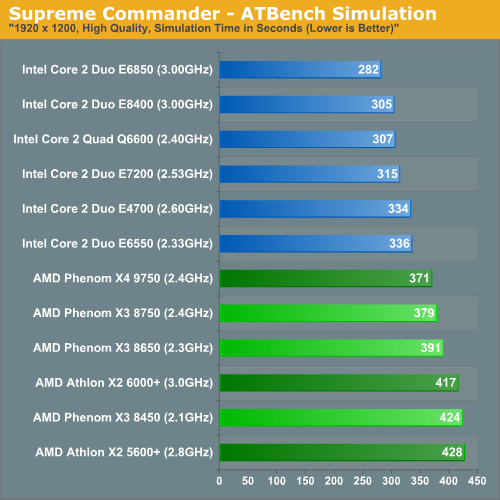
None of the AMD CPUs manage to do well here at all and despite Supreme Commander's ability to utilize more than two cores, the added benefit is small enough that triple-core doesn't really do much at all. Here we have another example of the Phenom X3 8450 performing on-par with the similarly priced Athlon X2s.
Crysis
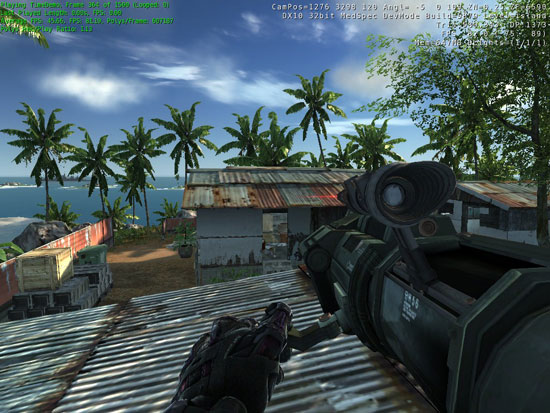
The most demanding FPS on the market right now is Crysis, and we couldn't resist using it as a benchmark. We ran at 1024 x 768 with Medium Quality defaults and used the game's built in CPU benchmark.

Clock speed is king under Crysis and thus the fastest AMD processor is the old 90nm Athlon X2 6000+ running at 3.0GHz, unfortunately not even it is really fast enough to be competitive here. Armed with low clock speeds, Phenom need not apply.
Half Life 2 Episode Two

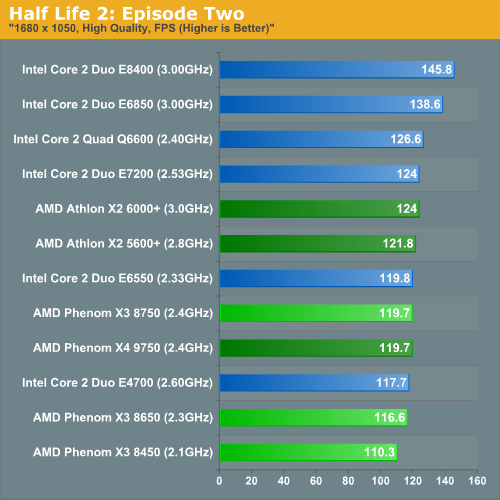
Half Life 2 continues the trend: the architectural enhancements of Phenom aren't enough to overcome its horrendously low clock speeds, the fastest AMD chip here is the aging Athlon X2.
Unreal Tournament 3
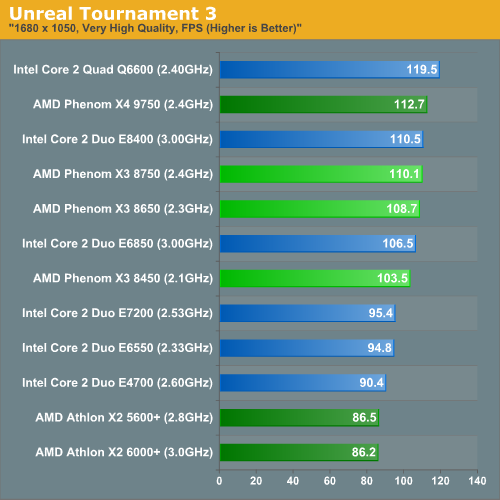
We finally see some balance in Unreal Tournament 3 thanks to some clever multi-threaded development. Here we see that modern code can run faster on Phenom than the Athlon X2, despite being at a significant clock speed disadvantage. Even compared to Intel, AMD manages to remain reasonably competitive but never quite superior.
Valve Map Compilation
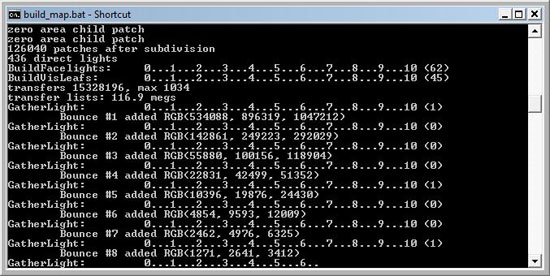
Valve supplied us with their VRAD map compilation tool to measure the performance of compiling Source engine maps.
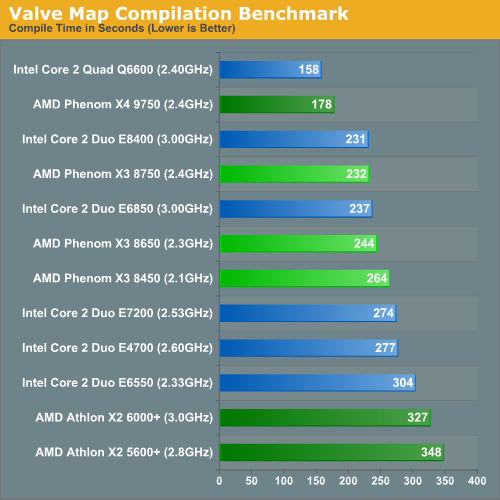
Valve's VRAD map compilation test scales very well with multiple cores and thus the Phenom X3 is pretty competitive here. AMD doesn't have the clock speed to compete against Intel's 3.0GHz E8400, so it must compete with more cores and it's exactly what we see here. The X3 8750 only runs at 2.4GHz but manages to perform on par with the 3.0GHz Core 2 Duo E8400 thanks to having that third core, which in this case is well utilized.
Unfortunately the map compilation test highlights a major issue with the triple-core strategy. Just as AMD is banking on not many applications needing quad-core, most applications don't need tri-core either and if you're running an application that doesn't benefit from three cores then the Phenom X3 behaves like a dual-core chip with a low clock speed. It's only in these well-threaded applications that triple-core can really shine, and they unfortunately aren't always the most common.










45 Comments
View All Comments
JarredWalton - Wednesday, April 23, 2008 - link
I've seen nothing to suggest a faster HyperTransport bus would help AMD much. You need to compare at the same CPU speed; if you raise the HT bus to 250 MHz that represents a 25% overclock of the CPU as well, so of course it helps performance a lot. Try comparing:Athlon X2 4600+ 2.4GHz
Run at 200 HTT and 12X CPU vs. 240 HTT and 10X CPU
Athlon X2 4800+ 2.5GHz
Run at 200 HTT and 12.5X CPU vs. 250 HTT and 10X CPU
(Note: the 12.5X multiplier vs. 10X may have an impact - half multipliers may not perform optimally.)
Athlon X2 5000+ 2.6GHz
Run at 200 HTT and 13X CPU vs. 260 HTT and 10X CPU
Now, the one thing you'll also have to account for is memory performance. At default settings (i.e. DDR2-800), you get different true memory speeds. The 12X CPU will end up at a true DDR2-800; the 12.5X will end up at DDR2-714 (CPU/7 yields 357MHz base memory speed); the 13X will result in DDR2-742 (again, CPU/7 yields 371 MHz base memory speed). For the "overclocked HT bus" setups, you'll need to select the same memory dividers to get apples-to-apples comparisons, which depending on motherboard may not be possible.
Unless you can do all of the above, you cannot actually make any claims that HyperTransport bus speeds are the limiting factor. I imagine you may see a small performance boost from a faster HT bus with everything else staying the same, but I doubt it will be more than ~3% (if that). HT bus only communicates with the Northbridge (chipset), and the amount of traffic going through that link is not all that high. Remember, on Intel that link to the chipset also has to handle memory traffic; not so on AMD platforms.
ghitz - Wednesday, April 23, 2008 - link
The e8400 performance/power usage is outstanding and will be great value once the G45 boards trickle in. I can't wait for those G45s!ap90033 - Wednesday, April 23, 2008 - link
So AMD STILL hadnt caught up. Thanks Good to know. Not that Im suprised....natebsi - Wednesday, April 23, 2008 - link
The bottomline is: AMD's newest CPU's are bested in nearly every single benchmark by an Intel CPU thats been out like, what, a year?I have no love/hate relationship with either Intel or AMD, but thats just sad. I predict many more losing quarters for them, though I don't know how many more they can take...
Griswold - Thursday, April 24, 2008 - link
Thanks for that null-posting.najames - Wednesday, April 23, 2008 - link
As a long time AMD only user, I just bought an Intel Q6600 on impusle from Frys.com for only $180. I was looking at a 780G solution and thought, I'll get the Intel quad and a similar Intel based solution for doing video processing work. Oops, I found out the only current Intel mATX is the G35 is from Asus, ONE BOARD, huge selection to choose from huh?I'll either sell/return the unopened CPU or buy a P35 board and graphics card. I could deal with a slightly slower AMD 9550 CPU and a better platform instead, tough choice.
strikeback03 - Wednesday, April 23, 2008 - link
I needed parts for a new system for the lab last week, I went with the non-integrated graphics and add-on card. Integrated graphics would have been fine for the application, but when the board plus card cost less than the ASUS G35 board (and are full-size ATX as well, which is useful) then the decision wasn't too hard.Staples - Wednesday, April 23, 2008 - link
Intel graphics have always been terrible. AMD definitely has the advantage for integrated graphics and even know their CPUs can not compete, I still find myself considering one just for their graphic options. I am glad that this review points it out bringing to light that Intel graphics are just not acceptable. Whether Intel will change is a big unknown, probably not.I find the added emphasis over the last year of power consumption a great one. With the price of energy these days, it is something I factor into my purchase. SSE4 and a lower power consumption is the reason I am holding out for a Q9450. Hopefully by the time it actually goes into mass production (hopefully in the next two months), a decent integrated option will be out for the platform.
0roo0roo - Thursday, April 24, 2008 - link
terrible? i used an intel 950 integrated graphics with some 1080p content, it decoded just fine with an e2200.derek85 - Thursday, April 24, 2008 - link
Terrible? Yes, terrible. Besides the lame hardware they can't even write proper drivers, see how many randering problems they have in the games.